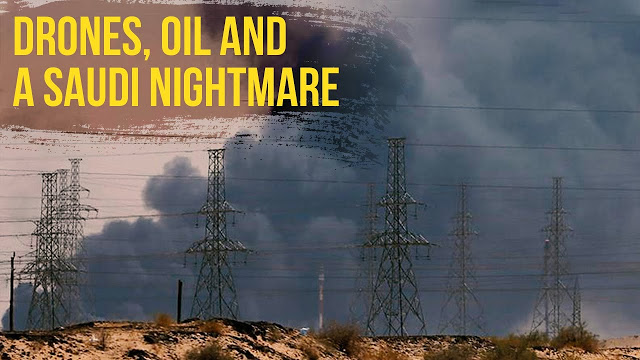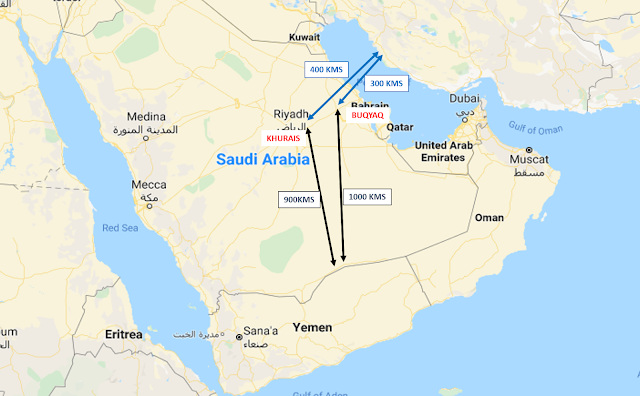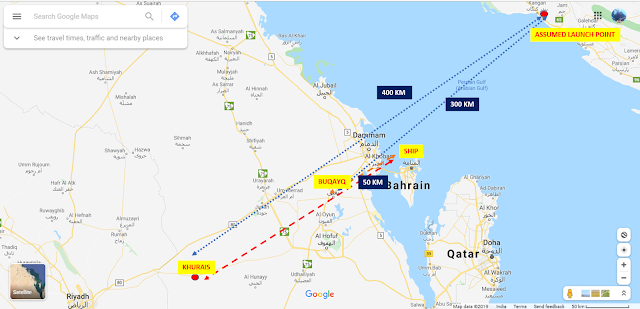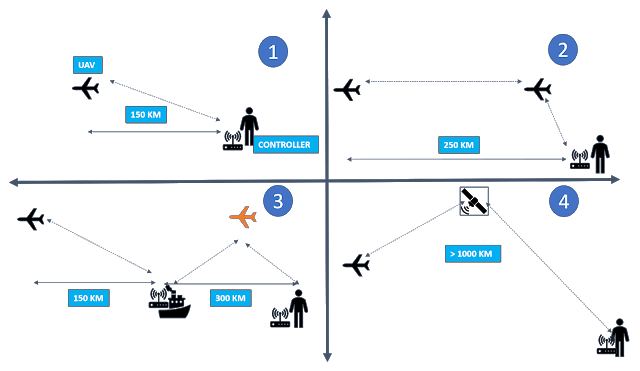
The Aramco Attacks
The outcomes. On September 14 this year at about 0400 hours, the Aramco oil refineries at Khurais and Abqaiq were attacked. The attacks were simultaneous in two waves. It was reported that the attacks were carried out using a combination of 25 Unmanned Aerial Vehicles (UAVs) and cruise missiles. Analysis later revealed that there were 19 strikes including on 14 storage tanks, three oil processing trains and two misses. The attacks shutdown the facilities and cut Saudi Arabia’s oil production down by 5.7 million barrels of oil per day. That was about five per cent of global oil production. There is no news about full revival yet. The attack destabilised world financial markets, and put huge question marks on the way future wars are to be fought. The Houthi rebels of Yemen claimed responsibility. These were discarded and the needle of suspicion swung to Iran, which kept quiet. Later reports emerged that said one of their Generals had said “Time to Take Out the Swords”. However, in the aftermath of the attack, everyone started negotiating for peace with Iran. Minimum input and maximum output. To that extent it seems logical that Iran engineered this attack. The attack was spectacular for many reasons. However, it was spectacular in its sophistry of planning and execution. We have a lot to learn from this operation.
Reconstruction Basics. This is an educated reconstruction of the operation and various issues involved in it and as to how this operation could have been carried out. It is by no means the truth or based on established facts. In fact, it is based on my imagination and fundamental knowledge of UAV technologies and operations. At the outset I would like to surmise that these were not quadcopter kind of operations. If some one can prove to me that they were quadcopter drones, then I will prove that it was done from within Saudi soil. That is a different ball game altogether. In my opinion this was an operation carried out using fixed wing UAVs. That is what we will analyse. I am not analysing the cruise missile part of the story.
The Planning Parameters

Iran or Yemen? The needle of suspicion has been oscillating between the Houthis and Iran. To put it in perspective, the distances involved are significant. From the Yemen border, Khurais and Abqaiq are 900 -1000 km. Mounting an UAV based operation from such distances is really beyond the capabilities of rebels. From mainland Iran, the distances are 300 – 400 km to these targets. The feasibility of attacks from Iran gain credibility based on shorter distances involved. Since the international community has virtually concluded that the attacks originated from Iran, I will try to reconstruct as to how the UAV attacks could have been carried out from an assumed site in Iran.
Intelligence. To carry out such precision attacks one needs intelligence about targets at first. It includes vulnerable areas and their precise locations on the military grid system of the attacker. Ideally extensive air photos/ satellite pictures as also ground based photographs would be needed. Secondly any attacker would need the layout and deployment of air defenses to include their orientation, their early warning systems, AD weapons and Radar coverages. As much as information of the coverage and deployment areas are required, there would be a need to identify the blind spots in the capability of the Air Defence System in operation. There would be a requirement of terrain and population intelligence so that the approach to the targets would be through uninhabited areas in the deserts to avoid detection. Very importantly, there would have been some in depth analysis of air activity in the area since the Gulf area has many international airports and all these would have to be avoided. There would also be a requirement of intelligence pertaining to shipping movement in the Persian Gulf. It is my guess that the limpet mine attacks in the Gulf of Oman would have reduced the traffic in the Gulf to the minimum at night. Those attacks have a bearing on this operation. Some additional activity for diversion would have been planned to ensure undetected passage of UAVs across the Persian Gulf. After all about two dozen UAVs would have to cross about 250 km expanse of sea, which is approximately 2-2.5 hours of flying time. This crossing would have been done at low levels of flying. The attack was carried out on a full moon night which indicates that moon light was probably needed to identify targets. Hence any sophisticated high-end night vision equipment was not probably used. Overall, this operation was not a hasty cobbled one. It was a well thought out operation probably part of a contingency plan which was on the anvil.

Basic Premises. Since there are no reports of missiles having been fired from UAVs, I am assuming that the UAVs were weaponised with laden explosives. In any case the targets were also combustible and hence weapon lethality and capability were probably minimal, rudimentary, simple and effective. The crow flight distance between an assumed launch site on the Iranian cost and Khurais is about 400 km. Hence the UAVs for this mission would need to have an endurance of 600 km at least to traverse an operational route avoiding air defences and habitation. This translates to about six hours endurance at an estimated speed of 110-125 kmph.
The UAVs. Given these parameters, the UAVs could have been in the weight class of about 50 to 100 kg which gives them a payload capacity of about 10-20 kg. With these payload capacities at least 5-10 kg of explosive and a simple optical sighting cum surveillance system could have been packed into each UAV to weaponise them and convert them into loitering missiles. The UAVs, in my opinion would have been made of either plastic or even balsa wood. UAVs of such capability would not have wing spans of more than 2.4 – 3m. Overall their radar cross section would have been very less. In addition, if they were painted with special paints, they could not have been detected by the Air Defence Radars. As is evident from the reports the UAVs were launched in four packets of 5-6 each. The first two packets were probably for Khurais and the next two after a gap of an hour or so would have been to Abqaiq. This is surmised since the attacks on both oilfields were simultaneous and Khurais is in depth by about 100 km from Abqaiq.

Control Plan of UAVs. This is where the plan gets interesting. A UAV needs to be controlled. Normally they are controlled from ground. When controlled from ground, the range of the UAV would be a maximum of 150 km, which is the effective line of sight communication range (see 1). Beyond that the range can be increased to about 250 km through an aerial relay (see 2). In this case such a tactic was not used since the aerial relay UAV would be a dead giveaway. The other option is to launch the UAV from the Iran coast and fly across the Gulf. Midway, hand over its control to a forward controller(s) on a ship off the Coast of Saudi Arabia (see 3). This forward controller(s) can then guide the UAVs to their targets. A ship off the coast of Saudi Arabia in the Persian Gulf would be approximately 50 km from Abqaiq and 150 km from Khurais. Hence ship based controller(s) will enable both targets to come within range. Yet another option is to control the UAVs through a satellite (see 4). SATCOM operations as they are known, require a complicated and a highly technically enabled UAV. The problem with SATCOM is that, any cloud interference could have interrupted operations. For any single shot operation like this, SATCOM control becomes too ‘iffy’. My appreciation is that the UAVs were handed over to a forward controller on a ship. The last option is of course to have a forward controller near the target. That means physical insertion and placement of a controller at least in between / near one or both the oilfields. A risky option which cannot be ruled out.
Innovations and Swarming. The next question is, were the UAVs swarmed? Highly possible. Again, my educated guess is that each packet was sent in a swarm mode. Reasons. Full swarming means that any common technical glitch renders the whole operation null and void. No swarming means that each UAV would need two controllers – one at launch and one in between. Hence the most balanced option would be to have each packet in a swarm. It gives redundancy and will be within trained manpower resources. There are other notable issues. Were these UAVs launched on wheels or on rails? It doesn’t matter which since the whole operation was a one-way exercise. I doubt if it was intended to recover any of them. To that extent the UAVs would be low cost and disposable. However, that is not the issue. The sum of the whole story is that lot of innovation and imagination has been used. This has been backed by the will of the state and a fully flexible pragmatic approach towards using UAVs.
National Effort
The technologies put together are impressive. Any nation should aspire for such capabilities. The question to ask is can India pill off such an operation. The COAS talks of non-contact operations. We are entering an era of multi domain operations. We are a major military power in the region. However, in my estimate we are far from even thinking of such operations. The DRDO has not been able to come up with any kind of minimalist UAVs for over 20 years despite full funding. I have witnessed the ongoing Nishant-Rustom development for the past couple of decades lurching from one failure to the next. By the time it succeeds, the operational goal posts would have moved halfway across the globe. The Services have been unimaginative in their approach in developing UAVs beyond the DRDO. They have steadfastly looked at Israel and US for last generation UAVs at exorbitant cost. Even after paying up exorbitant costs the foreigners keep milking us exorbitantly for spares and maintenance. Yes. We continue to depend on outsiders to maintain our operational UAVs on AMC basis even after two decades. With all this effort can we boast of putting together an operation of this kind. Of course not. How can you get next generation multipurpose low-cost disposable UAVs developed when we do not have even a programme of doing so? Our disjointed MoD with Services squabbling on who should own the UAVs rather than what we need to do to get hold of them is yet another case study of our inability to garner our indigenous technologies when these are being wooed by others. Do not worry. We are all set to buy Indian Technology sold to US or Israel or whoever for a pittance. Did someone say – Make in India? He forgot to add-through foreign shores at whopping cost 10 years later.
I AM CHALLENGING SOME ONE TO MAKE ME EAT CROW








